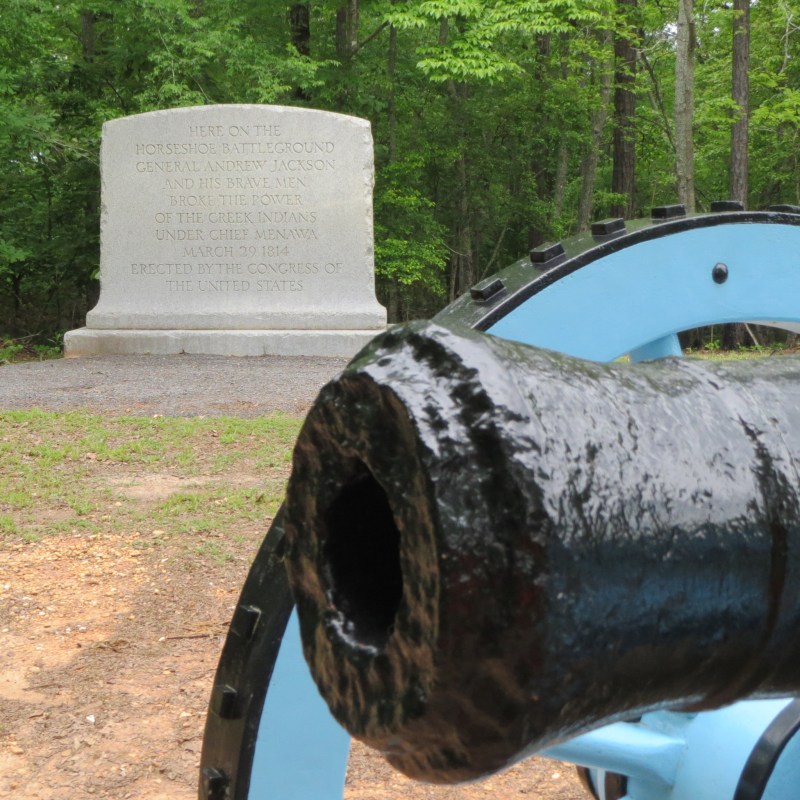
Hidden away along the thousands of miles of hiking trails across the country are fascinating looks at America’s past and historic sites that the average tourist will never see.
Videos by TravelAwaits
Alabama has many such trails, too many to mention here, that will take you back in time to the good — and bad — times in American history.
Here are seven of the best historic hikes in Alabama. Unless otherwise noted, the mileages given for these hikes are the total length of the trek. Please remember when visiting any historic site that collecting artifacts is a federal crime. And remember to practice the seven principles of Leave No Trace when you visit to keep the sites pristine.

1. Kinlock Shelter
Haleyville
A short 1-mile hike leads to an incredible piece of history — Kinlock Shelter. The shelter is a mammoth sandstone rock wall that towers above the valley floor with a deep cave-like entrance that Native Americans have used for centuries as a place of spiritual worship and ceremony. Look closely and you will find ancient petroglyphs adorning the walls.
Of all the historic sites I will mention, when you visit Kinlock, please treat this spiritual site with the utmost respect and reverence.
The hike begins just off Kinlock Road near the town of Haleyville on a nondescript, unblazed trail. It is an easy walk for the most part except for a steep descent the last tenth of a mile (and I mean steep) down to the valley floor and the shelter.
The non-profit organization Wild Alabama leads hikes to the shelter throughout the year. Visit their website for scheduled hikes.

2. Historic Blakeley State Park
Spanish Fort
Meander the long-deserted streets of the town of Blakeley at Historic Blakeley State Park.
The town was located on the banks of the Mobile-Tensaw River Delta almost exactly across the bay from the city of Mobile and, in fact, once rivaled the city as the state’s largest port city.
Forty-five separate trails ranging in length from a tenth of a mile to 2.1 miles interconnect to give you plenty of hiking options. The beautiful and easy walking trails are lined with oak trees adorned with Spanish moss that lead you to the foundation of the old courthouse, the beautiful banks of the delta, and eventually to the site of the last major battle of the Civil War.
The park is located on Alabama Highway 225 in Spanish Fort. The park is open from 8 a.m. to sunset. Admission is $4 for adults, $3 for children ages 6 to 12, and kids under 6 can visit for free.

3. Red Mountain Park
Birmingham
The reason Birmingham is called the “Magic City” is that this once sleepy, unassuming town became what it is today with the discovery that all three ingredients to make steel — hematite (iron ore), limestone, and coke (coal) — are found here. In fact, it is only one of a handful of places in the world where all three can be found in a single location.
Over 15 miles of trails ranging from easy to moderate hikes weave their way through this history at Red Mountain Park in Birmingham. Hike highlights include several stops at long since abandoned mines with their entrances blocked off with cement plugs for safety reasons etched with the years they were in operation and the beautiful mission-style architecture of the Redding Shaft Mine and Hoist House.
Besides hiking the trails, there are plenty of biking paths, treehouses, and overlooks for a panoramic view from high above the ground and miles of ziplines for an exciting ride through the tree canopy. What makes Red Mountain Park extra special is the Butler Snow Sensory Trail, a path specially designed for children and adults with special needs so that they, too, can experience the wonders of nature.
The park is located on Frankfurt Drive and is open from 7 a.m. to 5 p.m. Any day of the week, the park can be very busy, so plan to arrive early.

4. Ruffner Mountain Nature Preserve
Birmingham
Another wonderful green space in the Birmingham area is the Ruffner Mountain Nature Preserve. The preserve is not only known for its rich biodiversity and acclaimed nature center but also for the Birmingham steel history found here.
The 15 miles of easy to difficult trails take you to the quarry, where limestone was once mined for the steel industry and a hidden artifact — a huge iron ore crusher that stands silently in the forest.
You will find Ruffner on 81st St. South in Birmingham. The trails are open seven days a week from dawn to dusk, nature center Tuesday — Saturday 9 a.m. to 5 p.m., Sundays 1 p.m. to 5 p.m. Admission is free, but a donation is requested to keep the mission of the preserve moving forward.

5. Russell Cave National Monument
Bridgeport
Travel back in time 10,000 years with a visit to Russell Cave National Monument in Bridgeport, Alabama.
Operated by the National Park Service, the enormous rock shelter is the site of one of the most complete records of prehistoric cultures in the Southeast.
The park has a 1.6-mile-long moderately difficult paved trail that winds its way up a mountainside. Along the way, interpretive signage depicts the life of Native Americans who lived here thousands of years ago.
The main attraction is the cave itself, which is ADA accessible via a half-mile boardwalk that starts at the visitor center.
Before heading out, take the time to watch the short introductory film at the visitor center that traces the cave’s history and its inhabitants, then return to the visitor center to view the fascinating exhibits. The cave is open 7 days a week from 8 a.m. to 4:30 p.m., closed major holidays. You will find the cave on County Road 98 in Bridgeport.

6. Tannehill Ironworks Historical State Park
McCalla
We’ll dive one more time into the Birmingham area’s fascinating iron and steel history by paying a visit to the Tannehill Ironworks Historical State Park in McCalla.
A 4.1-mile easy loop trail using the Slave Quarters Trail, Old Bucksville Stage Road, Iron Haul Road Trail, and Cemetery Trail will take you past the beautiful, swift-flowing turquoise waters of Roupes Creek. The trail will lead you to a slave cemetery and then take you to an incredible towering hand-laid stone furnace.
A visit to the park is capped off with a tour of the Iron and Steel Museum of Alabama, where hundreds of artifacts from the birth of Birmingham and its burgeoning steel industry. And there are plenty of activities held throughout the year that will make you want to return to Tannehill time and time again, like the Pioneer Farm and craft cabins where blacksmiths, quilters, and various other artisans do live demonstrations of their craft, the giant Trade Days flea market, and so much more. Visit the park’s event calendar for details.
The park and museum are open 7 days a week, the park from sunrise to sunset, the museum from 10 a.m. to 4 p.m. Park admission is $5 adults, $4 seniors over 62 and older, $3 children 6 to 11, free for children under 3. Museum admission is $2.

7. Horseshoe Bend National Military Park
Daviston
An easy 2.8-mile loop hike on the Horseshoe Bend Nature Trail is a beautiful walk through a mixed forest, along the banks of the wide Tallapoosa River, and across wide, green pastures. But there is more to it than just a walk in the woods.
This trail at the Horseshoe Bend National Military Park in Daviston also traces the tragic event that took place here. On March 27, 1814, a bloody and decisive battle waged on this spit of land eventually led to the end of the Creek Indian War. It shaped the course of history for the region’s tribes over the next few decades, culminating in their removal during the Trail of Tears.
The park is located on Horseshoe Bend Road in Daviston and is open 7 days a week from 8 a.m. to 5 p.m. The visitor center, which features excellent exhibits and a fascinating film on the battle, is normally open every day (besides Thanksgiving, Christmas, and New Year’s Day) from 9 a.m. to 4:30 p.m, but it is currently closed during the COVID-19 pandemic. In normal times, admission is free, but donations are appreciated.
Related Articles:
